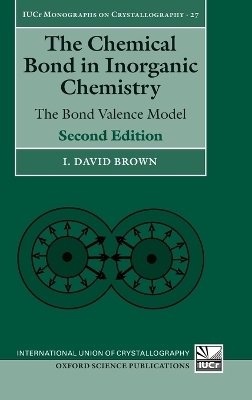
The Chemical Bond in Inorganic Chemistry
The Bond Valence Model
Seiten
2016
|
2nd Revised edition
Oxford University Press (Verlag)
978-0-19-874295-1 (ISBN)
Oxford University Press (Verlag)
978-0-19-874295-1 (ISBN)
This book shows how chemical properties arise naturally from the conflict between the constraints of chemistry and those of three-dimensional space. Accessible to anyone with secondary school knowledge of chemistry and physics, the bond valence model is widely used for analysing and modelling the structures and properties of solids and liquids.
The bond valence model, a description of acid-base bonding, is widely used for analysing and modelling the structures and properties of solids and liquids. Unlike other models of inorganic chemical bonding, the bond valence model is simple, intuitive, and predictive, and is accessible to anyone with a pocket calculator and a secondary school command of chemistry and physics. This new edition of 'The Chemical Bond in Inorganic Chemistry: The Bond Valence Model' shows how chemical properties arise naturally from the conflict between the constraints of chemistry and those of three-dimensional space. The book derives the rules of the bond valence model, as well as those of the traditional covalent, ionic and popular VSEPR models, by identifying the chemical bond with the electrostatic flux linking the bonded atoms. Most of the new edition is devoted to showing how to apply these ideas to real materials including crystals, liquids, glasses and surfaces. The work includes detailed examples of applications, and the final chapter explores the relationship between the flux and quantum theories of the bond.
The bond valence model, a description of acid-base bonding, is widely used for analysing and modelling the structures and properties of solids and liquids. Unlike other models of inorganic chemical bonding, the bond valence model is simple, intuitive, and predictive, and is accessible to anyone with a pocket calculator and a secondary school command of chemistry and physics. This new edition of 'The Chemical Bond in Inorganic Chemistry: The Bond Valence Model' shows how chemical properties arise naturally from the conflict between the constraints of chemistry and those of three-dimensional space. The book derives the rules of the bond valence model, as well as those of the traditional covalent, ionic and popular VSEPR models, by identifying the chemical bond with the electrostatic flux linking the bonded atoms. Most of the new edition is devoted to showing how to apply these ideas to real materials including crystals, liquids, glasses and surfaces. The work includes detailed examples of applications, and the final chapter explores the relationship between the flux and quantum theories of the bond.
David Brown is Professor Emeritus at the Department of Physics and Astronomy, McMaster University, Hamilton, Ontario, Canada.
Preface
1: Historical introduction
2: The flux theory of the chemical bond
3: The bond valence model
4: Cation coordination number
5: Hydrogen bonds
6: Liquids
7: Electronically distorted structures
8: Physical properties of bonds
9: Space and space groups
10: Modelling inorganic structures
11: Steric strain
12: Applications
13: Chemical implications
App. 1: Bond valence parameters
App. 2: Space group spectra
App. 3: Refcodes
App. 4: Glossary
| Erscheinungsdatum | 07.09.2016 |
|---|---|
| Reihe/Serie | International Union of Crystallography Monographs on Crystallography ; 27 |
| Verlagsort | Oxford |
| Sprache | englisch |
| Maße | 171 x 234 mm |
| Gewicht | 696 g |
| Themenwelt | Naturwissenschaften ► Chemie ► Anorganische Chemie |
| Naturwissenschaften ► Chemie ► Physikalische Chemie | |
| Naturwissenschaften ► Geowissenschaften ► Mineralogie / Paläontologie | |
| Naturwissenschaften ► Physik / Astronomie ► Festkörperphysik | |
| ISBN-10 | 0-19-874295-9 / 0198742959 |
| ISBN-13 | 978-0-19-874295-1 / 9780198742951 |
| Zustand | Neuware |
| Haben Sie eine Frage zum Produkt? |
Mehr entdecken
aus dem Bereich
aus dem Bereich
Buch | Hardcover (2012)
Westermann Schulbuchverlag
CHF 44,90
Schulbuch Klassen 7/8 (G9)
Buch | Hardcover (2015)
Klett (Verlag)
CHF 29,90
Buch | Softcover (2004)
Cornelsen Verlag
CHF 23,90


